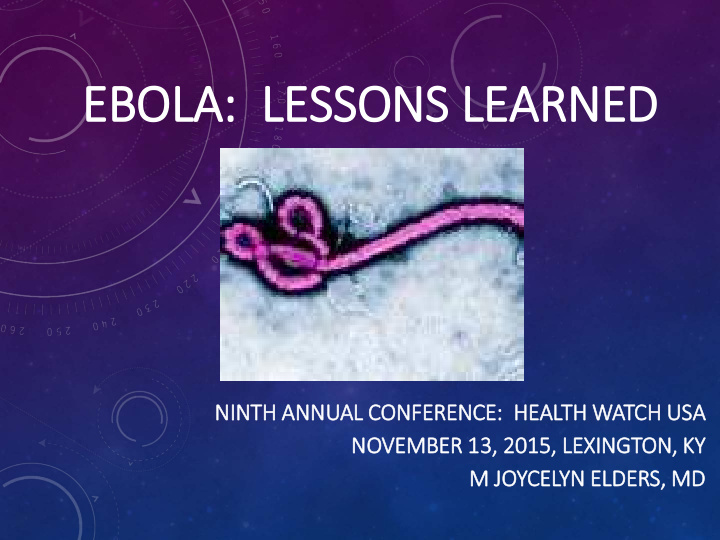



EBOLA LA: LESSONS LEAR ARNED NINTH NTH ANNU NNUAL CONF NFERENCE: HEAL ALTH TH W WATCH U USA SA NOVEMBER 13, 13, 2015 2015, LEXINGTON, K KY M M JOYCE CELYN ELDERS, MD MD
EPIDEMIOLOGY • Total cases 28,636 • Laboratory-confirmed cases 15,246 • Total deaths 11,314 • Mortality rate 90 - 23% • Deployed medical teams 50 • Mobile laboratories 28 • Trained experts 7,000
HOW DO YOU GET THE EBOLA VIRUS? Direct contact with: 1. Body fluids of a person who is sick with or has died from Ebola (blood, vomit, urine, feces, sweat, semen, spit, other fluids) 2. Objects contaminated with the virus (needles, medical equipment) 3. Infected fruit bats or primates (apes and monkeys) CDC
" Ebola Hemorrhagic Fever Signs and Symptoms". CDC . 28 January 2014. Retrieved 2 August 2014.
08/08/2014 International Ebola Emergency Declared by the Global Health Security Agenda
GLOBAL HEALTH STRATEGY Strengthen public health systems • Prevent when possible • Detect rapidly • Respond effectively Iden entify S Stop op Preven ent
3 CORE INTERVENTIONS TO STOP EBOLA OUTBREAK • Exhaustive case and contact findings • Effective response to patient and community • Isolate and treat patients. • Monitor each contact for 21 days.
KEY PREVENTIVE INTERVENTIONS • Meticulous information control in healthcare setting • Education of community • Cultural sensitivity • Avoid handling of bush meat and contact with bats. • Stringent control efforts • Safe burial Vaccine •
“Outbreak anywhere can be a risk everywhere.” Thomas Frieden, MD Director of CDC
APIC A Assoc ociation on for P Professionals i in Infection on Control ol Nov, 4 4, 2015 S 15 Survey o of Members o on Ebola P Prepa parednes edness s in US US Hea Healthcare F e Facilities s On One Y Year L r Later r - 15,00 000 0 mem embe bers / s / 981 981 respo ponden ndents • 92 92% t thin ink f facilit litie ies a are b better prepa epared 92% think facilities are better prepared • 55% f facilit litie ies n not provid vided a addit itio ional r l resources • 62 62% c contin inue t train inin ing • 25% 25% l lack P PPE per per CDC g gui uidelines • 722, 2,00 000 p 0 patien ents s contract H H/C-assc. I Inf nfection n (2011) 011) • 53% of of IPs report ort that t they a are s sol olo o physicians • 59% 59% o of PICs c cover er m more t e tha han o one ne facility
LESSONS LEARNED • Every country needs core public health functions to identify a threat when it occurs. • Must stop outbreak by moving immediately and decisively. (HCWs 42 X vs. Non HCWs) • Must have effective infection prevention and control procedures in hospitals and other healthcare facilities. • Must have: • appropriate triage procedures • adequate personnel preventive equipment • adequate infection control practices
Study and implement CDC Guidelines in preparation for Ebola Epidemic
RECOMMENDATIONS FOR PREPARING FOR FUTURE EPIDEMICS • Be coordinated by a global institution that is given enough authority and funding to be effective. • Enable fast decision-making at a global level. • Expand investment in research and development and clarify regulatory pathways for developing new tools and approaches. • Improve early warning and detection systems, including scalable everyday systems that can be expanded during an epidemic. • Involve a reserve corps of trained personnel and volunteers, • Strengthen health systems in low- and middle-income countries. • Incorporate preparedness exercises to identify the ways in which the response system needs to improve. (NEJM.org, April 9, 2015)
Recommend
More recommend